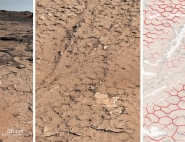CHEMCAM
CHEMCAM performs the elemental analysis of rocks and soils around the Curiosity rover as far as nine metres. It uses the Laser Induced Breakdown Spectroscopy technique (LIBS). A powerful laser shoots a target, which causes the fusion of the material and produces a plasma that is detected by UV-visible spectroscopy. This new and never flown technique enables to perform the first selective analysis of surrounding rocks on Mars without having to move the rover. After using information from CHEMCAM, the rover approaches rocks to perform more detailed analyses. The experiment is also equipped with a camera (RMI: Remote Micro-Imager) which provides a high resolution image of the sample to describe the context of the LIBS measurement.
How does the instrument work?
- It aims at a sample (distance between 2-9 m).
- It takes an image of the sample (around 750 nm).
- It sends the pulsed laser beam toward this sample (1 GW/cm²).
- It collects the light emitted by the sample for a spectral analysis (between 250-800 nm).
![]()
Illustration of how CHEMCAM works.
Credits CEA
Roger Wiens, PI from Los Alamos National Laboratory (LANL), is responsible for CHEMCAM the instrument. Sylvestre Maurice, Deputy-PI from IRAP (ex-CESR), is responsible for CHEMCAM French contribution: CHEMCAM-MU ("Mast Unit" constituted of a laser, a telescope, an RMI camera and the associated electronics).



